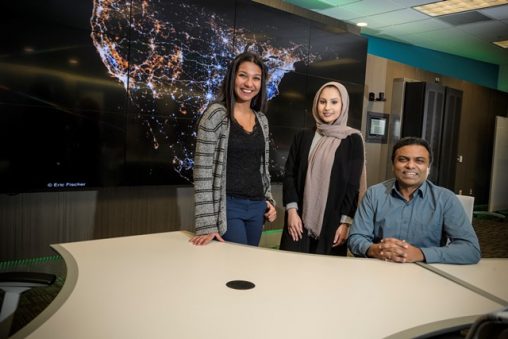
From left: Sarika Sivagnanam, a management information systems graduate; Raneem Barri, an accounting and management information systems major; and Anand Jeyaraj, professor of information systems and supply chain management; in the DAVE lab. (Photo by Erin Pence)
On a towering, 12-section video screen on the second floor of Rike Hall, data comes to life. Statistics are transformed into graphs, maps, timelines and even videos that give the numbers true meaning.
It is part of the Data Analytics and Visualization Environment, or DAVE lab, at the Raj Soin College of Business.
The 1,000-square-foot lab, which features a mini supercomputer as well as visualization software, opened in the fall of 2015. It is used to teach students business analytics, a fast-growing field that is quickly becoming a huge part of how corporations and organizations do their jobs.
“It’s the trend of business,” said Arijit Sengupta, associate dean and professor of management information systems. “You go anywhere and there’s analytics. It is pretty much everywhere.”
Business analytics focuses on developing new insights and understanding business performance based on data. It makes extensive use of statistical analysis, including explanatory and predictive modeling, to drive decision-making.
Companies use data analytics to optimize inventory, predict the appeal of future products, create efficiencies and to shape customer loyalty programs. Banks use data analysis to match customer characteristics such as bank usage and credit risk with appropriate product offerings. A cookie company may use data analysis to improve its recipes or come up with different flavors.
Any student can take analytics classes. Wright State students majoring in marketing, finance and master of information systems can couple their major with a concentration in business analytics. And a business analytics certificate is available to current business students or those who have graduated and want to come back for the certificate.
Anand Jeyaraj, professor of information systems and supply chain management, teaches Introduction to Business Data, the first course in the business analytics concentration.
“Organizations today have access to a ton of data, but sometimes they don’t know what they have or what they could do with it,” said Jeyaraj.
Students acquire data from multiple sources, collect it in a single location, select the relevant information and then use software tools to analyze it and find meaningful and useful knowledge. Several organizations have donated data to the lab.
“The DAVE lab has servers that house specific kinds of software, which are tools students will use to run their analysis or visualize their data so they can reach their findings,” said Jeyaraj. “They can actually see the data.”
Raneem Barri, a student majoring in accounting and management information systems, took a data analytics class in the lab.
“I don’t think it would have been as impactful had it been in a normal classroom,” Barri said. “The DAVE lab just has so many capabilities. We were able to visualize the data and have it actually come to life.”
Sarika Sivagnanam, who graduated in December after earning her bachelor’s degree in management information systems, also spent time in the lab.
“The DAVE lab is completely different from a regular classroom. You walk in and you can feel the difference,” Sivagnanam said. “The classes I’ve had here I feel are more interactive. It’s more hands-on than a typical class.”
The large, wall-sized screen in the lab is segmented into 12 different sections. It can display 12 different sets of data and images at once or any number of combinations, such as four sets of data on three screens, two sets of data on six screens and so forth.
“We can have students working in groups and they can put their own analysis in different parts,” said Sengupta.
The lab exposes students to the latest analytics platforms, similar to those used by large corporations but on a slightly smaller scale. The lab’s mini supercomputer has servers that can handle up to 220 terabytes of data.
“One of the great things about having the servers right here is that students get hands-on experience in how to work with servers, how to troubleshoot things,” said Sengupta.
Graduates with a proficiency in analytics can get jobs as business analysts, data scientists or data architects.

 Bags, boards and bonding
Bags, boards and bonding  More than 1,000 students to graduate at Wright State’s fall commencement ceremonies
More than 1,000 students to graduate at Wright State’s fall commencement ceremonies  Wright State’s Take Flight Program helps students soar high
Wright State’s Take Flight Program helps students soar high  Wright State Police Department delivers major donation to Raider Food Pantry
Wright State Police Department delivers major donation to Raider Food Pantry  Wright State engineering and computer science students earn prestigious federal SMART Scholarships
Wright State engineering and computer science students earn prestigious federal SMART Scholarships 